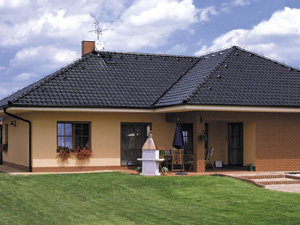
Sliding bags without batten replacement
 |
The great advantage of using sliding tiles lies mainly in the possibility of laying them on the original battening. Thanks to the tolerance in cover length, they are suitable for almost all batten spacing. All tiles can be used for roofs with a minimum slope (safe slope) of 30°, a tight under-roof of 24°, or a waterproof under-roof of 20°.
Polka can be purchased in a raw finish, as well as in red and brown engobe. Polka 13 has a cover length ranging from 315 - 365 mm, where the optimal cover length is 325 - 355 mm.
The sliding Hranice 11 is produced in a matte to semi-gloss finish with brown and red engobe or with a high-gloss glaze "Amadeus" in red and black variants. The consumption for one square meter of roof starts from 10.8 pieces of tiles. Hranice 11 is a stamped tile with deep grooves, and its design allows it to be laid on roof battens with spacing of 340 – 400 mm.
The main advantages of the tile Stodo 12 include the possibility of choosing interesting color variations. The engobe finish offers copper and old gray, while the glaze has an attractive slate black and chestnut brown. The consumption of tiles for one square meter of roof is from 12.2 pieces. Once laid, Stodo 12 creates a modern elegant structure of the roof surface with an emphasis on horizontal lines.
Brněnka 14, characterized by its specific shape of the troughs that widen towards the foot of the tile, is available on the market in a raw finish, and can also be purchased in the forms of red, anthracite, and brown engobe. The consumption of tiles for one square meter of roof is from 14.5 pieces.
All types of burnt roof coverings are produced on a natural basis, where a mixture of soil with added clay is mixed with water, air-dried, and environmentally fired in gas-heated kilns. The tiles gain their color through glazing or engobe technology. They offer not only high strength and resistance to weather effects and chemical loads but also the advantages of burnt material – ecological properties and breathability. Therefore, the manufacturer guarantees maximum resistance to UV radiation, acid rain, snow, and hail. Due to the manufacturing process, the tiles are color-fast, and over time there is no change in color and no so-called "weathering", unlike colored tiles made from other materials.
The English translation is powered by AI tool. Switch to Czech to view the original text source.











